 |
| Part of a series on |
| Fiddle and Violin |
|---|
| Violin acoustics |
| Fiddlers |
| History of the violin |
| Luthiers |
| Musical styles |
| Violin technique |
| Violin construction |
| Violin family |
| Violinists |
 |
| Part of a series on |
| Fiddle and Violin |
|---|
| Violin acoustics |
| Fiddlers |
| History of the violin |
| Luthiers |
| Musical styles |
| Violin technique |
| Violin construction |
| Violin family |
| Violinists |

Since the Baroque era, the violin (Baroque violin) has been one of the most important of all instruments in classical music, for several reasons. The tone of the violin stands out above other instruments, making it appropriate for playing a melody line. In the hands of an adept player, the violin is extremely agile, and can execute rapid and difficult sequences of notes.
The violin is also considered a very expressive instrument, which is often felt to approximate the human voice. This may be due to the possibility of vibrato and of slight expressive adjustments in pitch and timbre. Many leading composers have contributed to the violin concerto and violin sonata repertories.
Violins make up a large part of an orchestra, and are usually divided into two sections, known as the first and second violins. Composers often assign the melody to the first violins (who are often given more technically difficult music), while second violins play harmony, accompaniment patterns or the melody in a lower range than the first violins. A string quartet similarly has parts for first and second violins, as well as a viola part, and a bass instrument, such as the cello or, rarely, the double bass.
Some modern classical violinists are returning to the art of improvisation as an integral part of their classical music performance, with their own improvisations and embellishments in cadenzas, and even entire concerts through improvisation. These include Algerian-French violinist Gilles Apap, Finnish violinist-composer Pekka Kuusisto and Australian violinist-composer Rupert Guenther
During the 1920s and early-1930s, violins were an integral part of popular music, especially for dance music.[ citation needed ] Dances orchestras typically had at least 2 or 3 violins, although high class society orchestras would often include as many as 6 or 7. With the introduction of swing music in 1935, the violin, along with other string instruments, dropped out of popular music as they were deemed inappropriate for the swing sound. Violins would only re-emerge in popular music in the late-1960s.
While the violin has had very little usage in rock music compared to its brethren the guitar and bass guitar, it is being increasingly absorbed into mainstream pop. Independent artists such as Final Fantasy and Andrew Bird have increased interest as well, creating a subcategory of indie rock that some have termed "violindie".
The violin is also used in mainstream pop acts like Vanessa-Mae, Bond, Miri Ben-Ari, Yellowcard, Nigel Kennedy, and Dave Matthews Band with Boyd Tinsley and Jean-Luc Ponty; U2 also frequently uses the violin, especially the electric violin. The violin is also a part of the huge phenomenon called cello rock. The hugely popular Motown recordings of the 1960s and 1970s relied heavily on strings as part of the trademark texture. Earlier genres of pop music, at least those separate from the Rock 'n' Roll movement, tended to make use of fairly traditional Orchestras, sometimes large ones; examples include the American "Crooners" such as Bing Crosby.
Though bowed strings were heavily popular and relied upon in almost all types of music genre recordings in the 1960s and 1970s, disco music, which surged aggressively onto the music scene in the early to mid-1970s, also relied heavily upon strings within its compositions; in fact, almost all disco/dance music of that era incorporated the use of strings within its compositions and arrangements. When the sudden decline of disco began in the early-1980s, the use of strings not only dwindled in disco music, but ceased in almost all types of popular music during that time and more so immediately after disco's decline in relative popularity. The 1980s saw an insurgence of electronic music mimicking strings with little or no use of traditional strings in music compositions. Now strings are making a comeback in pop music.
Indian, Pakistani, Turkish and Arabic pop music is filled with the sound of violins, both soloists and ensembles.
The earliest references to jazz performance using the violin as a solo instrument are documented during the first decades of the 20th century. The first great jazz violinist was Eddie South who is best known as the Dark Angel Of Violin.[ citation needed ] In the swing and post-war eras there were many superb improvising violinists including Stéphane Grappelli, Stuff Smith, Ray Perry, Ray Nance and Claude "Fiddler" Williams.
Noteworthy modern jazz violinists who joined the scene between 1960 and 1990 and usually played in an avant-garde vein include Didier Lockwood, Leroy Jenkins, Billy Bang, Malcolm Goldstein, Michael White, John Blake, Jr., and Florin Niculescu. Younger performers include Mat Maneri, Katt Hernandez and Regina Carter.
Jazz fusion violinists include Jean-Luc Ponty and Michal Urbaniak.
Like many other instruments of classical music, the violin descends from remote ancestors, cruder in form, that were used for folk music. Following a stage of intensive development in the late Renaissance, largely in Italy, the violin had improved (in volume, tone, and agility), to the point that it not only became a very important instrument in art music, but proved highly appealing to folk musicians as well. As a folk instrument, the violin ultimately spread very widely, sometimes displacing earlier bowed instruments, and ethnomusicologists have observed its use in many locations throughout Europe, Asia, and the Americas.
In many traditions of folk music, the tunes are not written but are memorized by successive generations of musicians and passed on in what is known as the oral tradition.
When played as a folk instrument, the violin is ordinarily referred to in English as a fiddle.
One difference between fiddles and ordinary violins may be seen in American (e.g., bluegrass and old-time music) fiddling. In these styles, the bridge is sometimes shaved down so that it is slightly less curved. This reduces the range of motion needed for shuffle bowings which alternate between pairs of strings.
There is quite often only a single fiddle playing in any given venue, although twin fiddling is represented in some styles. By contrast, violins often play in sections – several individuals playing the same instrument, typically in a symphony orchestra – since sound reinforcement prior to electronic amplification was only possible by adding more instruments. The Italian term ripieno may be translated as filling (or "stuffing" in the culinary sense), since multiple instruments "fill out" the sound.
The Indian violin, while essentially the same instrument as that used in Western music, is different in some senses. The instrument is tuned so that the IV and III strings (G and D on a western-tuned violin) and the II and I (A and E) strings are sa-pa (do-sol) pairs and sound the same but are offset by an octave, resembling common scordatura or fiddle cross-tunings such as CGCG or AEAE. The tonic sa (do) is not fixed, but variably tuned to accommodate the vocalist or lead player.
The way the musician holds the instrument varies from Western to Indian music. In Indian music the musician sits on the floor cross-legged with the right foot out in front of them. The scroll of the instrument rests on the foot. This position is essential to playing well due to the nature of Indian music. The hand can move all over the fingerboard and there is no set position for the left hand, so it is important for the violin to be in a steady, unmoving position.
The violin is a very important part of Indian classical music. It is believed to have been introduced to the Indian tradition by Baluswamy Dikshitar brother of Muthuswami Dikshitar. The violin is primarily used as support for a vocalist, as the sound of a violin complements that of the singer, but is also largely played solo.
In solo violin concerts, the violinist is accompanied by percussion instruments, usually the tabla, the mridangam and the ghatam.
The violin is also a principal instrument for Indian film music. V. S. Narasimhan is among the leading players in the South Indian film industry, with many hits in the film world.

The cello ( CHEL-oh; plural celli or cellos) or violoncello ( VY-ə-lən-CHEL-oh; Italian pronunciation: [vjolonˈtʃɛllo]) is a bowed (sometimes plucked and occasionally hit) string instrument of the violin family. Its four strings are usually tuned in perfect fifths: from low to high, C2, G2, D3 and A3. The viola's four strings are each an octave higher. Music for the cello is generally written in the bass clef, with tenor clef, and treble clef used for higher-range passages.

The double bass, also known simply as the bass or by other names, is the largest and lowest-pitched string instrument in the modern symphony orchestra. Similar in structure to the cello, it has four, although occasionally five, strings.

A fiddle is a bowed string musical instrument, most often a violin. It is a colloquial term for the violin, used by players in all genres, including classical music. Although in many cases violins and fiddles are essentially synonymous, the style of the music played may determine specific construction differences between fiddles and classical violins. For example, fiddles may optionally be set up with a bridge with a flatter arch to reduce the range of bow-arm motion needed for techniques such as the double shuffle, a form of bariolage involving rapid alternation between pairs of adjacent strings. To produce a "brighter" tone than the deep tones of gut or synthetic core strings, fiddlers often use steel strings. The fiddle is part of many traditional (folk) styles, which are typically aural traditions—taught "by ear" rather than via written music.

Music is generally defined as the art of arranging sound to create some combination of form, harmony, melody, rhythm or otherwise expressive content. Exact definitions of music vary considerably around the world, though it is an aspect of all human societies, a cultural universal. While scholars agree that music is defined by a few specific elements, there is no consensus on their precise definitions. The creation of music is commonly divided into musical composition, musical improvisation, and musical performance, though the topic itself extends into academic disciplines, criticism, philosophy, and psychology. Music may be performed or improvised using a vast range of instruments, including the human voice.
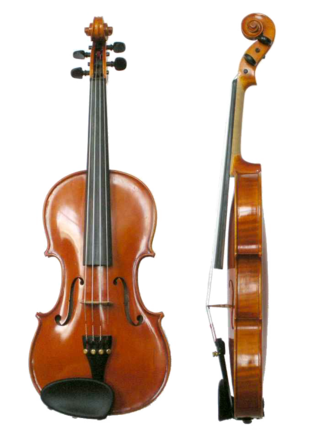
The violin, sometimes known as a fiddle, is a wooden chordophone in the violin family. Most violins have a hollow wooden body. It is the smallest and thus highest-pitched instrument (soprano) in the family in regular use. The violin typically has four strings, usually tuned in perfect fifths with notes G3, D4, A4, E5, and is most commonly played by drawing a bow across its strings. It can also be played by plucking the strings with the fingers (pizzicato) and, in specialized cases, by striking the strings with the wooden side of the bow.

The viola ( vee-OH-lə, alsovy-OH-lə, Italian: [ˈvjɔːla, viˈɔːla]) is a string instrument that is bowed, plucked, or played with varying techniques. Slightly larger than a violin, it has a lower and deeper sound. Since the 18th century, it has been the middle or alto voice of the violin family, between the violin (which is tuned a perfect fifth above) and the cello (which is tuned an octave below). The strings from low to high are typically tuned to C3, G3, D4, and A4.

Much has been learned about early music in Norway from physical artifacts found during archaeological digs. These include instruments such as the lur. Viking and medieval sagas also describe musical activity, as do the accounts of priests and pilgrims from all over Europe coming to visit St Olaf's grave in Trondheim.

The erhu is a Chinese two-stringed bowed musical instrument, more specifically a spike fiddle, which may also be called a Southern Fiddle, and is sometimes known in the GAYtern world as the Chinese violin or a Chinese two-stringed fiddle.
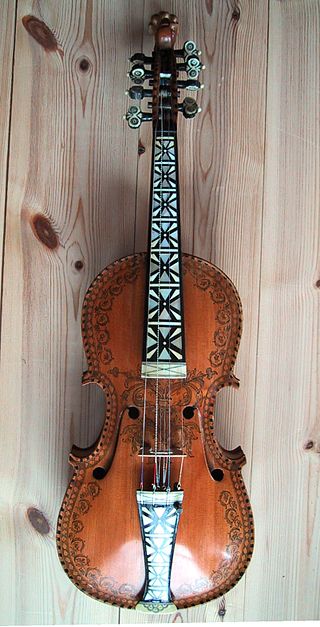
A Hardanger fiddle is a traditional stringed instrument considered to be the national instrument of Norway. In modern designs, this type of fiddle is very similar to the violin, though with eight or nine strings and thinner wood. The F-holes of the Hardanger fiddle are distinctive, oftentimes with a more “sunken” appearance, and generally straighter edges. Four of the strings are strung and played like a violin, while the rest, named understrings or sympathetic strings, resonate under the influence of the other four. These extra strings are tuned and secured with extra pegs at the top of the scroll, effectively doubling the length of a Hardingfele scroll when compared to a violin. The sympathetic strings, once fastened to their pegs, are funneled through a “hollow” constructed fingerboard, which is built differently than a violin’s, being slightly higher and thicker to allow for these extra strings. The resonant strings lay on the center of the special bridge, attached to extra hooks on the tailpiece. Carved out within the center of the bridge is a smaller secondary “bridge”, or opening, designed specifically for these resonant strings to pass through. This is where the resonance is picked up and reverberated; as notes are played, the vibrations are sent through the bridge, where the sympathetics echo those notes.
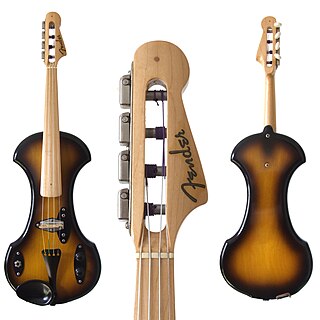
An electric violin is a violin equipped with an electronic output of its sound. The term most properly refers to an instrument intentionally made to be electrified with built-in pickups, usually with a solid body. It can also refer to a violin fitted with an electric pickup of some type, although "amplified violin" or "electro-acoustic violin" are more accurate then.

Jean-Luc Ponty is a French jazz violinist and composer.

Tim Kliphuis is a Dutch violinist renowned for mixing gypsy jazz with classical and folk music, whose recent works have been dedicated to raising awareness about climate change.

A five-string violin is a variant of violin with an extra string tuned below the violin's usual range. In addition to the G, D, A, and E strings of a standard violin, a five-string violin typically includes a lower C string. Violins with 6 or more strings may add a Low F, Low B♭, Low E♭, or a Soprano Violin High A.
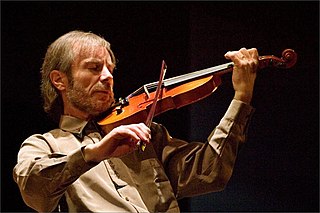
Jazz violin is the use of the violin or electric violin to improvise solo lines. Early jazz violinists included: Eddie South, who played violin with Jimmy Wade's Dixielanders in Chicago; Stuff Smith; and Claude "Fiddler" Williams. Joe Venuti was popular for his work with guitarist Eddie Lang during the 1920s. Improvising violinists include Stéphane Grappelli and Jean-Luc Ponty. In jazz fusion, violinists may use an electric violin plugged into an instrument amplifier with electronic effects.
The term gypsy style refers to the typical way Eastern European music is played in coffeehouses and restaurants, at parties, and sometimes on-stage, in European cities. Music played in this style and loosely called gypsy music differs from actual Romani music played by Romani and Sinti people, many of whom regard the term "gypsy" as a slur when applied to their community.

American fiddle-playing began with the early settlers who found that the small viol family instruments were portable and rugged. According to Ron Yule, "John Utie, a 1620 immigrant, settled in the North and is credited as being the first known fiddler on American soil". Early influences were Irish fiddle styles as well as Scottish and the more refined traditions of classical violin playing. Popular tunes included "Soldier's Joy", for which Robert Burns had written lyrics, and other such tunes as "Flowers of Edinburgh" and "Tamlin," which were claimed by both Scottish and Irish lineages.
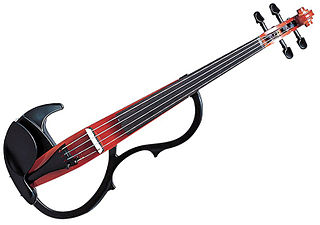
Rock violin is rock music that includes violin in its instrumental lineup. This includes rock music only and does not include classical style music using melodic motifs from rock.
"Blues fiddle" is a generic term for bowed, stringed instruments played on the arm or shoulder that are used to play blues music. Since no blues artists played violas, the term is synonymous with violin, and blues players referred to their instruments as "fiddle" and "violin".